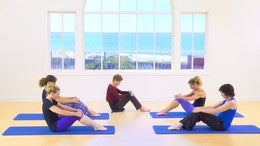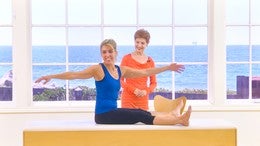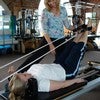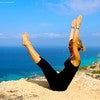Description
About This Video
Transcript
Read Full Transcript
This is the Aston Kinetics class for the 100 Kristy Cooper will be demonstrating the way that she, well she has many variations that she can do for the hundred as probably many of you have many very key variations, but let's just see one of them. Christie,
One of the things that I like to focus on in the people that I trained like to focus on is individualizing a, any activity we do for the person that we're working with. Um, there are certain common denominators and there are a couple of concepts that I just want to have you become aware of. Um, one of them is at the idea that a body starts in neutral from it's most available neutral first. So in this case neutral would be where my weight is more evenly distributed through my whole body on down through to my feet. So I'm aligned front to back. I'm not leaning back, I'm not sucking in, I'm just resting in this neutral position. So finding neutral. The second concept is when the body is in its best alignment, the forces of gravity coming through the body down and the ground reaction force that comes and pushes any object on the earth off the earth toward the stars.
It's called ground reaction. So when we know how to use gravity pulling us down and ground reaction pushing us off when we knew how to recycle those two forces, the work in the body, whether it's exercise, whether it's running, whether it's picking up your child, is more evenly distributed. So a couple of things have come to me about this particular setup that are compromising Christie's body just a bit. One is the amount of hyperextension at the tibial plateau that's going on. If she lets go of that and really hyper extends, she can go all the way down there. The laxity allows her to do this.
This is a very, very common pattern for people. When the knee hyper extends to that degree and the lower leg at the tibial plateau is supposed to cheerier, it pushes the lower leg back and the thigh forward. This is a setup for increasing tension on the front of the hip, on the front of the knee and many times at the posterior placement where pelvis in leg meat. So I'm going to have her start by focusing on bringing the tibial plateau. It may feel slightly bent to her, but I'm going to have her focus on bringing this slightly forward a little bit more, little bit more, little bit more.
So you're almost rocking down here on this bar. Can you feel that your leg and you'll be able to see this in the film now is really much more straight. Okay. And I would like you to use this ground reaction. Now to do the first movement, which is push off a slightly on the contact point with your left leg to bend your right leg up, push down with both hands onto the mat to GRF to bring the other leg up. Push both hands and GRF away from you, down into the Mat and away to not only lengthen your body, but tone your core. So now your body's in a toned, lengthened core position to begin the next move and bringing your arms up and flexing.
Now just that alone, relax. And tell me what you felt was different.
There you go. And then do one leg and then join with the other leg coming up and let them come down or let both legs come up at the same time. Okay. So it's definitely harder when you knew how to use the GRF with your hands and create traction to make your body really long. It facilitates being able to live. Yeah. Okay. So right now let's do this again.
Tibial plateau on the right leg forward one leg GRF with the hands again for the second leg. GRF with the hands again to Laith and all the way up through and top of your head. Yes. Wrong. You are long. Yeah. Now, just for fun. Let's go back and do this the other way with no GRF, no lengthening, but bilaterally at the same time. Both legs, right?
Let me give you one more cue for that. That's great. Thank you. So again, tibial plateau, GRF, Dubai, you are pushing the hands away. If you pull the hands towards you, you make yourself short and compressed. You push the hands into the mat and away linkedin somebody. But it also tolls the core so that the core is helping you lift the legs against the pull of gravity. Okay, so go ahead the legs. Think of the link going out the front of your body and the back of your body to come up. There you go.
Comments
You need to be a subscriber to post a comment.
Please Log In or Create an Account to start your free trial.


























